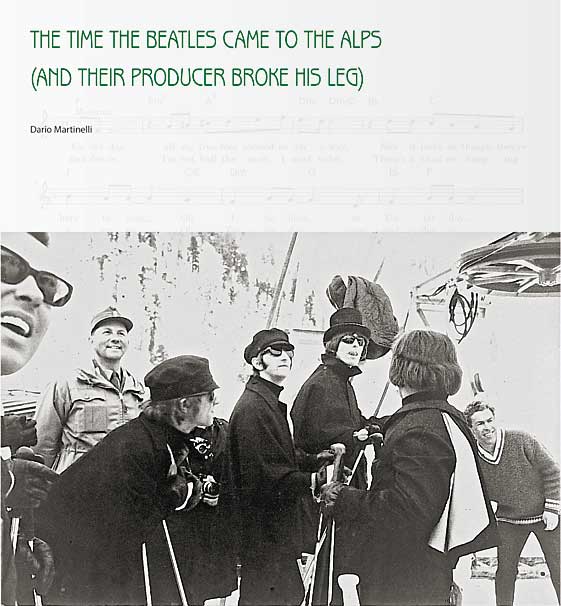
Maybe it was really a cable car. I'm talking about "Ticket to Ride" and one of the small mysteries surrounding interpretation of the Beatles' work. She dumps her boyfriend, walking out on him without a second thought. But "how" exactly does she leave him? For what means of transport is this "ticket to ride"? We really don't know. What is certain, however, is that the famous video accompanying the song (known nowadays as a "promo") depicts the Fab Four in a number of ungainly and slightly Chaplinesque ski sequences, up in the Austrian Alps. So, have you never thought that the ticket could be for a cable car, paying homage in a way to "Funiculì Funiculà"?
All right, it's not exactly a realistic possibility. More likely it was a bus.
But how did the Beatles come to be in the Alps?
In 1965, the four lads were already international celebrities. The year before, riding on this success, and also to document it in a semi-satirical way, they starred in the film "A Hard Day's Night", directed by Richard Lester. In those days, almost all successful singers automatically made films: you may remember the succession of musical comedies which came out in Italy, featuring the various talents of Little Tony, Rita Pavone or Gianni Morandi.
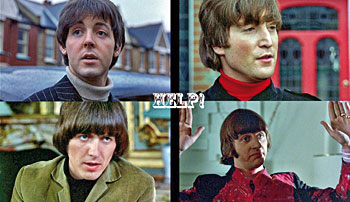 "A Hard Day's Night" went down very well, and it seemed only natural to follow it up by a second film, with Lester in charge once again (you don't change a winning team). This film was given the provisional title of "Eight Arms to Hold You", but was later renamed "Help!" after the song specially composed for it by Lennon and McCartney. Other songs were written for the occasion, and went on to fill Side A of a new LP record, and to form the film's soundtrack. ("Yesterday" was relegated to Side B, because it was considered too unusual to satisfy the fans' expectations… how far-sighted!). Amongst the tracks was this song: "Ticket to ride", which was also issued as a single. "A Hard Day's Night" went down very well, and it seemed only natural to follow it up by a second film, with Lester in charge once again (you don't change a winning team). This film was given the provisional title of "Eight Arms to Hold You", but was later renamed "Help!" after the song specially composed for it by Lennon and McCartney. Other songs were written for the occasion, and went on to fill Side A of a new LP record, and to form the film's soundtrack. ("Yesterday" was relegated to Side B, because it was considered too unusual to satisfy the fans' expectations… how far-sighted!). Amongst the tracks was this song: "Ticket to ride", which was also issued as a single.
With the aim of producing something different from the preceding film, Lester and his colleagues took their inspiration from the cinema sensation of the time, James Bond (played by Sean Connery). They decided to devise a parody, revolving around a powerful, mysterious ring, owned by Ringo Starr, which the villains of the piece are determined to steal. In keeping with the 007 dramas, the film had to be set in various exotic locations, and the Beatles themselves were asked where they would like to go for the shoot. The scriptwriters then used their list to construct the various scenes.
One of the Beatles' wishes was to spend a week skiing in the Alps.
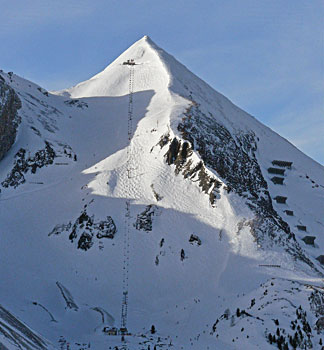 Not many people know this, but the chosen destination was Obertauern, not far from Salzburg, still a popular tourist resort for ski enthusiasts. The Beatles arrived there on March 13th 1965, only two days after getting back from the Bahamas (another exotic location for the film). They were put up at the Hotel Edelweiss, and each assigned a ski instructor (including Willi Grillitsch, who you can still find at his post in his ski-school). Not many people know this, but the chosen destination was Obertauern, not far from Salzburg, still a popular tourist resort for ski enthusiasts. The Beatles arrived there on March 13th 1965, only two days after getting back from the Bahamas (another exotic location for the film). They were put up at the Hotel Edelweiss, and each assigned a ski instructor (including Willi Grillitsch, who you can still find at his post in his ski-school).
They began filming the day after, often using doubles for the more dare-devil sequences. Had they but known it, these stand-ins would also have proved useful for the group's producer, George Martin. Although he was not involved in the actual filming, he decided to accompany his wards and also enjoy a week in the mountains. He had never skied before: he broke his ankle on his first day out and had to spend the rest of the holiday resting.
To return to the Beatles: apart from the "promo" for "Ticket to Ride" (where the four friends demonstrate in a comical manner the futility of engaging ski instructors), the other famous sequence shot at Obertauern was the scene at the curling competition with the bomb attack by the "baddies". The working holiday ended exactly a week after it started, and the Beatles returned to London to do another series of scenes at Twickenham Film Studios (where their last film, "Let It Be", was shot four years later).
It was at the London studios that the final "mountain" act of this little adventure took place. 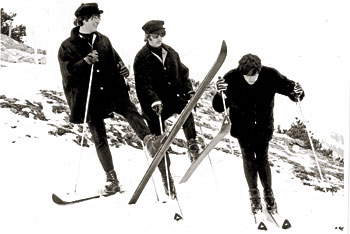 In the knowledge that the Alpine scenes typified the film more than any others - rather like the iconic opening sequence of "A Hard Day's Night" with the Beatles running from their fans - it was decided that the cover of the "Help!" album should have that type of setting. Returning to Obertauern was not an option, and so a snowy landscape was recreated in the studio, with the Beatles lined up and busy signalling with their arms what everyone at the time took to be the letters H, E, L and P. In the knowledge that the Alpine scenes typified the film more than any others - rather like the iconic opening sequence of "A Hard Day's Night" with the Beatles running from their fans - it was decided that the cover of the "Help!" album should have that type of setting. Returning to Obertauern was not an option, and so a snowy landscape was recreated in the studio, with the Beatles lined up and busy signalling with their arms what everyone at the time took to be the letters H, E, L and P.
Not at all.
It was the cover's photographer, Robert Freeman, who decided on the combination of arms for that rather un-photogenic word, by first suggesting that they try out a variety of positions. The arrangement that pleased them all and which finally featured on the album cover, resulted in the meaningless word "NUJV".
Won't you please, please NUJV me… probably wouldn't have made it to the top of the hit parade. |
 NUMBER 11
NUMBER 11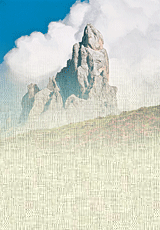
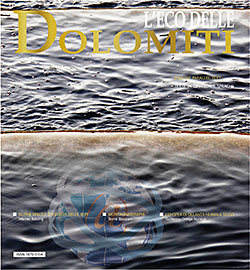

 "A Hard Day's Night" went down very well, and it seemed only natural to follow it up by a second film, with Lester in charge once again (you don't change a winning team). This film was given the provisional title of "Eight Arms to Hold You", but was later renamed "Help!" after the song specially composed for it by Lennon and McCartney. Other songs were written for the occasion, and went on to fill Side A of a new LP record, and to form the film's soundtrack. ("Yesterday" was relegated to Side B, because it was considered too unusual to satisfy the fans' expectations… how far-sighted!). Amongst the tracks was this song: "Ticket to ride", which was also issued as a single.
"A Hard Day's Night" went down very well, and it seemed only natural to follow it up by a second film, with Lester in charge once again (you don't change a winning team). This film was given the provisional title of "Eight Arms to Hold You", but was later renamed "Help!" after the song specially composed for it by Lennon and McCartney. Other songs were written for the occasion, and went on to fill Side A of a new LP record, and to form the film's soundtrack. ("Yesterday" was relegated to Side B, because it was considered too unusual to satisfy the fans' expectations… how far-sighted!). Amongst the tracks was this song: "Ticket to ride", which was also issued as a single.  Not many people know this, but the chosen destination was Obertauern, not far from Salzburg, still a popular tourist resort for ski enthusiasts. The Beatles arrived there on March 13th 1965, only two days after getting back from the Bahamas (another exotic location for the film). They were put up at the Hotel Edelweiss, and each assigned a ski instructor (including Willi Grillitsch, who you can still find at his post in his ski-school).
Not many people know this, but the chosen destination was Obertauern, not far from Salzburg, still a popular tourist resort for ski enthusiasts. The Beatles arrived there on March 13th 1965, only two days after getting back from the Bahamas (another exotic location for the film). They were put up at the Hotel Edelweiss, and each assigned a ski instructor (including Willi Grillitsch, who you can still find at his post in his ski-school).  In the knowledge that the Alpine scenes typified the film more than any others - rather like the iconic opening sequence of "A Hard Day's Night" with the Beatles running from their fans - it was decided that the cover of the "Help!" album should have that type of setting. Returning to Obertauern was not an option, and so a snowy landscape was recreated in the studio, with the Beatles lined up and busy signalling with their arms what everyone at the time took to be the letters H, E, L and P.
In the knowledge that the Alpine scenes typified the film more than any others - rather like the iconic opening sequence of "A Hard Day's Night" with the Beatles running from their fans - it was decided that the cover of the "Help!" album should have that type of setting. Returning to Obertauern was not an option, and so a snowy landscape was recreated in the studio, with the Beatles lined up and busy signalling with their arms what everyone at the time took to be the letters H, E, L and P.